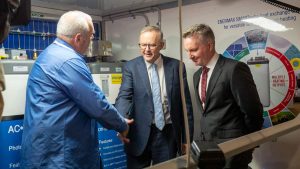This week as India was crossing the 50-gigawatt threshold for cumulative installed renewable energy capacity (excluding large hydro), the initial bids for its first major solar auction of 2017 were announced—and came in at a record low Rs3.59-3.64/kWh.
That’s down 16 percent year on year against the previous record low bid.
This trend is not occurring in a policy vacuum. India’s new draft National Electricity Plan, released in December, calls for a fivefold expansion to 258GW of renewable capacity by 2027, an expansion that would reduce thermal power capacity share to 43 percent of India’s total from 66 percent today.
The solar-auction results mean this target just got substantially easier and more cost effective to implement. Costs per unit of power to purchase are tumbling, and—of critical importance—it can now be shown that these prices are not only commercially viable but likely to beaten again in 2018, and again in 2019 as total solar costs continue to decline globally at a rate of 10 percent annually.
The implications for global renewable energy uptake, and the ongoing structural decline of seaborne thermal coal are clear.
Some detail:
Initial bids for the 750MW Rewa solar park in the Indian state of Madhya Pradesh came in at Rs3.59-3.64/kWh (US$53/MWh), against the previous record low bid of Rs4.34/kWh (US$64/MWh)accepted from Fortum of Finland for a 75MW project.
Fortum’s bid was 25 percent below the bids being lodged a year earlier, and there was consistent comment at the time that the bid was neither commercial nor sustainable, and would not be replicated. Subsequent solar bids consolidated at Rs4.50-5.00/kWh.
So these bids are not only commercially viable, they are replicable and sustainable.
We see Indian uptake of solar growing, and we think a key indicator in support of our outlook is that the Rewa solar tender was ten times oversubscribed, with 7.5GW of total bids from firms as diverse as India’s leading power conglomerates (e.g. the Adani group, Aditya, Hero), innovative global conglomerates (SoftBank of Japan in a joint venture with Foxconn of Taiwan), leading global utilities (Enel of Italy, GDF of France), and specialist Indian renewable firms (such as ReNew Power) backed by global financiers (ADB, Goldman Sachs and JICA of Japan). Sovereign wealth funds (Abu Dhabi Investment Authority) are also leveraging the rapidly developing global Green Bond market.
A whole host of factors are driving down the delivered cost of solar electricity in India, which is second in population only to China:
- Solar module costs have by dropped 30 percent over the past year.
- The Reserve Bank of India has delivered a succession of rate cuts since 2015 as inflation has fallen almost by half after Prime Minister Modi’s 2014 election, driving down the cost of finance.
- The Indian exchange rate has stabilized, allowing U.S.-dollar module costs to translate directly into the lower rupee cost of solar.
- Access to global capital for renewable infrastructure projects in India is rapidly expanding.
- Indian installers are learning by doing, and are now putting up the largest solar projects in the world (Adani’s 648MW Tamil Nadu project, commissioned in mid-2016), using the latest technologies.
- Solar tenders are backed by the Solar Energy Corporation of India (SECI), a central government entity providing an entirely bankable counterparty, circumventing the un-bankable state utilities (DISCOMs).
- Initial tariffs have a partial inflation protection mechanism via indexation.
Behind all of this is Energy Minister Piyush Goyal’s “TLC” policy on solar— transparency, longevity and certainty.
The investment needs of the Indian electricity sector over the next decade will approach US$1 trillion, presenting an opportunity that is now attracting the attention of the global majors who have historically overlooked India’s 1.3 billion people and its 7 percent annual economic growth rate.
The clear conclusion in the government’s December electricity-development plan is that India need not build any new coal-fired power capacity over the next decade. This conclusion was reinforced with the Central Electricity Authority this week reporting a drop in the average thermal power plant utilization rate in the nine months to December 2016 fell to a decade-low 59.6 percent.
Goyal’s target to cease thermal coal imports into India looks like a commercial certainty—imported coal-fired power generation is the risky, high cost option. Renewable energy capacity is targeted to increase fivefold to 258GW, and investment in other zero emission technologies (nuclear and large hydro) are targeted for a near doubling, to 94GW.
Indian solar tariffs of US$54/MWh are likely to continue falling by 5 to 20 percent annually for the next decade.
All this news from India bodes ill for international coal markets, and raises questions about an Australian project we have followed closely.
With the Adani group announcing this week it targets USD$2bn of investment in solar in 2017 alone, one must clearly question if there is any remaining strategic or commercial merit in Adani Enterprises’ ongoing pursuit of the remote and now stranded low-quality export thermal coal proposal at Carmichael in Queensland’s Galilee Basin.
In IEEFA’s view the only way the Carmichael proposal can proceed is with a massive government subsidy to underwrite as much as AU$10 billion of project risk involved. While the North Australia Infrastructure Fund (NAIF) has been pushed to provide a subsidy of $AU 1 billion, the balance remains unfunded and is a key project risk.
Tim Buckley is IEEFA’s director of energy finance studies, Australasia.









